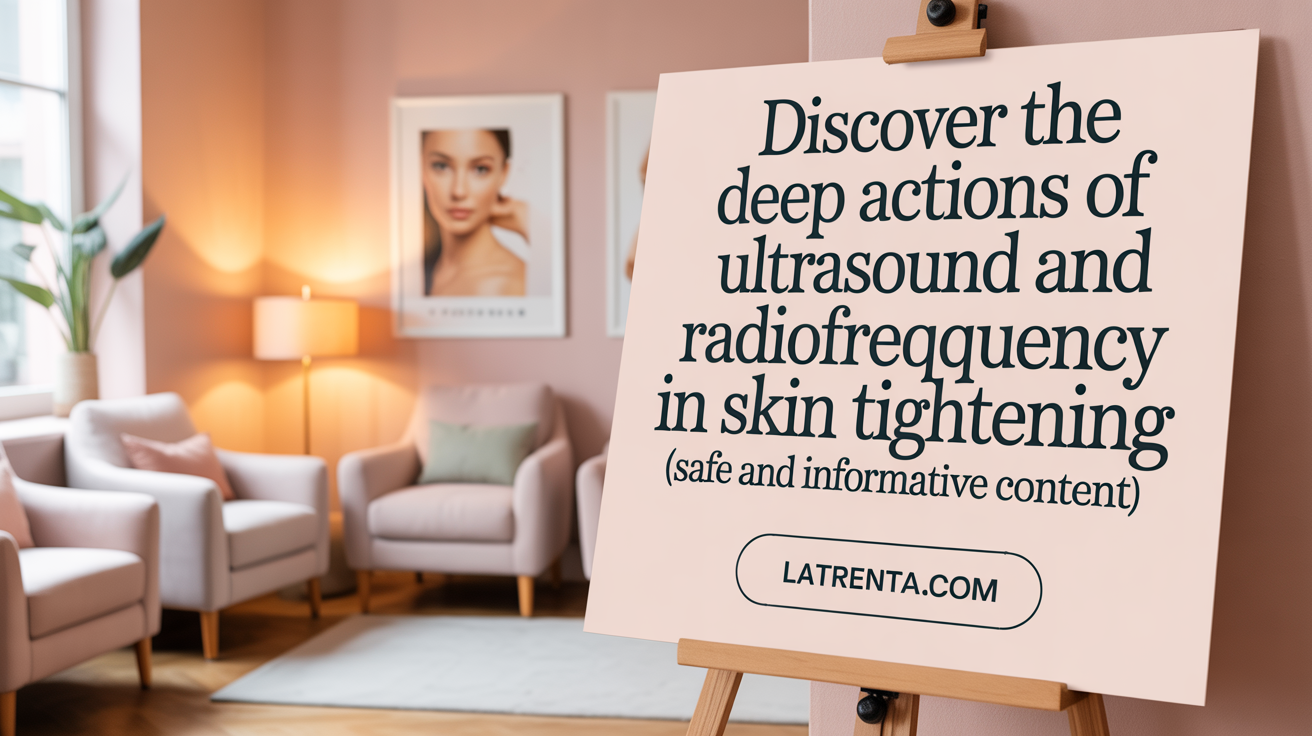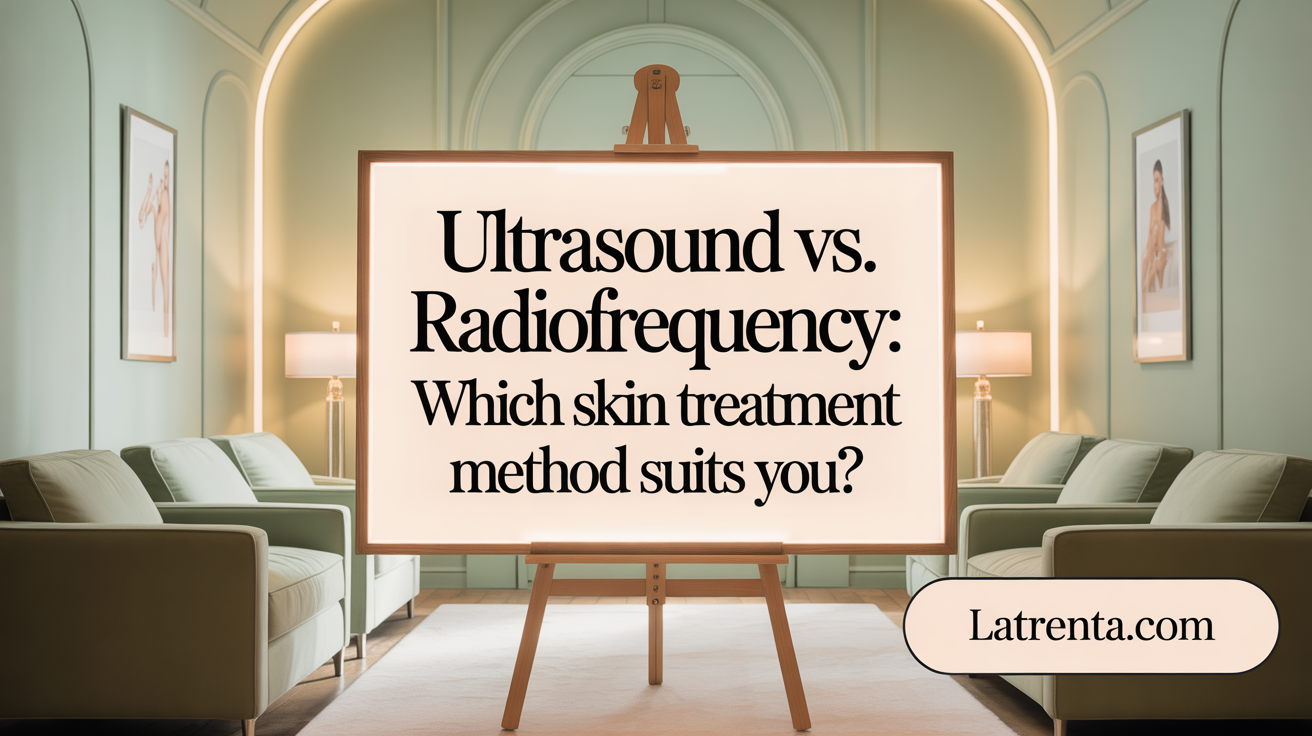Understanding Skin Tightening Technologies
Skin tightening treatments have revolutionized non-surgical cosmetic care, offering solutions for sagging skin and signs of aging without the risks of invasive surgery. Two prominent technologies—ultrasound and radiofrequency—harness energy to stimulate collagen production, restore skin elasticity, and improve contours. This article delves into how these methods work, their unique benefits and limitations, and guides you in choosing the best option for your individual skin concerns and goals.
How Ultrasound and Radiofrequency Skin Tightening Work: Mechanisms and Biological Effects

What are the differences between radiofrequency and ultrasound skin tightening?
Radiofrequency (RF) mainly heats the dermis using electromagnetic waves, which stimulates the production of collagen and elastin to improve skin firmness and reduce wrinkles. It is typically effective for mild to moderate skin laxity and can treat larger body areas with quicker sessions. Ultrasound treatments, such as high-intensity focused ultrasound (HIFU), deliver sound wave energy that penetrates deeper into the skin, targeting the SMAS layer—a strong connective tissue layer. This allows for more effective lifting and tightening, especially in the face and neck regions. While RF influences the surface and mid-dermal layers to tighten skin gradually, ultrasound goes deeper, providing a structured lift and longer-lasting results. Both methods promote collagen remodeling, but they differ significantly in depth of penetration and the nature of their effects.
Mechanism of ultrasound in skin tightening
Ultrasound skin tightening uses high-frequency sound waves, focused precisely on targeted tissues. These sound waves generate thermal effects within deeper skin layers, including the SMAS, stimulating collagen fibers and promoting tissue contraction. Ultherapy, a common ultrasound treatment, utilizes real-time imaging to visualize skin layers during the procedure. This targeted energy causes controlled micro-damage, which signals the body to produce new collagen and elastin, leading to gradual skin lifting and tightening. Ultrasound energy can reach depths of around 4.5 mm, making it effective for lifting sagging skin in delicate areas like the brow, chin, and neck. The biological response involves collagen fiber remodeling, thickening of the dermis, and improved skin elasticity over the following months.
Mechanism of radiofrequency in skin tightening
Radiofrequency (RF) employs electromagnetic waves that produce controlled heat within the skin’s deeper layers, usually between 40°C and 48°C. This heat causes tiny micro-injuries in collagen fibers, which triggers the body's natural healing processes. The result is new collagen and elastin formation, leading to skin contraction and overall tightening. RF treatments are effective for reducing fine lines, wrinkles, and improving skin texture. RF devices are capable of heating the dermis uniformly, and some can also target subcutaneous fat, aiding in contouring and cellulite reduction. Collagen remodeling happens gradually, with visible effects developing over several weeks to months.
Differences in energy delivery and tissue penetration
Radiofrequency delivers energy via electromagnetic waves, primarily affecting the superficial to mid-dermal skin layers. It heats tissues to induce collagen synthesis and tissue tightening. Ultrasound, on the other hand, uses sound waves that focus energy at specific depths, often reaching the SMAS layer—more than 4 mm deep. This allows for a more profound structural lift. The depth and nature of energy deposition influence the treatment goals: RF is better for surface issues like fine lines and mild laxity, while ultrasound is suited for deeper lifting in facial and neck tissues.
Targeted skin layers and treatment depth
RF treatments typically target the dermis and sometimes the superficial subcutaneous tissue depending on the device and settings. They are effective for improving skin texture, tone, and mild laxity. Ultrasound treatments aim at deeper layers, including the SMAS, which helps in lifting sagging tissues and providing a more significant, longer-lasting lift. Ultherapy PRIME®, for example, combines real-time ultrasound imaging with focused sound waves to ensure precise targeting, adjusting depth based on individual anatomy.
This distinction in depth of penetration and mechanism allows practitioners to select the appropriate technology based on specific skin concerns, desired outcomes, and treatment areas.
Comparing Ultrasound and Radiofrequency: Advantages, Drawbacks, and Suitability

What are the benefits and drawbacks of radiofrequency skin tightening compared to ultrasound?
Radiofrequency (RF) and ultrasound are both popular non-invasive skin tightening methods, each with unique advantages. RF treatments are generally more comfortable, with minimal pain, and can be applied to larger body areas like thighs and abdomen. They also involve shorter session times, often around 30 to 60 minutes, with results visible within 4 to 12 weeks, lasting up to two years with maintenance.
Ultrasound treatments, such as Ultherapy, penetrate deeper into tissues like the SMAS layer, providing a more targeted lift especially for the face and neck. These treatments tend to have longer-lasting effects that can extend beyond a year and improve tissue structure. However, ultrasound procedures may cause more discomfort during treatment, requiring more careful patient management.
Common side effects for both treatments are mild and temporary, such as redness, swelling, or minor tenderness. RF might cause slight heat sensation and rare minor blistering, while ultrasound can lead to discomfort, redness, or swelling that resolve within a few days.
For which skin concerns and treatment areas are ultrasound or radiofrequency more suitable?
Ultrasound is especially effective for deeper tissue lifting, making it ideal for areas requiring structural enhancement such as the jawline, neck, and décolletage. It is suitable for moderate to severe skin sagging and is often chosen for patients seeking a natural, lasting lift.
In contrast, RF is better suited for mild to moderate skin laxity, especially on larger surface areas like the face, arms, or thighs. It is effective at smoothing fine lines, improving skin tone, and reducing mild wrinkles and cellulite. RF treatments are often preferred for more superficial skin concerns and for patients who want shorter sessions with less discomfort.
Both modalities can be combined for comprehensive rejuvenation, but the choice depends on the specific skin concern, depth of tissue laxity, and treatment goals.
Treatment Experience and Practical Considerations: Sessions, Discomfort, Downtime, and Safety

What should patients expect regarding treatment outcomes, downtime, risks, and result timelines for ultrasound and radiofrequency skin tightening?
Both ultrasound and radiofrequency (RF) treatments generally require multiple sessions to achieve optimal results. Ultrasound sessions, such as Ultherapy, typically last between 30 to 60 minutes, focusing on deep tissue layers with targeted sound wave energy. RF treatments can take slightly longer, often up to 90 minutes, depending on the area being treated.
Patients usually experience a sensation of warmth or mild discomfort during procedures. Ultherapy might cause brief redness or swelling, which resolves within a few days. RF treatments tend to be more tolerable, with a mild heat sensation and minimal side effects.
Downtime is minimal for both options. Patients can often return to their normal routines immediately after treatment, with only minor redness or warmth possibly lingering for a day.
These procedures are generally very safe when performed by trained, qualified professionals using FDA-approved devices. Side effects are rare and typically mild, including temporary redness, swelling, or slight discomfort.
Results from both technologies develop gradually due to ongoing collagen remodeling. Visible improvements tend to be noticeable within 2-6 months post-treatment. The longevity of results varies: ultrasound effects can last up to a year or more, especially with maintenance, while RF results generally last from 12 to 24 months. Proper skincare and occasional touch-up sessions can help sustain the benefits over time.
In summary, patients can expect effective skin tightening with minimal downtime, safe procedures, and results that improve gradually over several months, with effects lasting up to two years depending on the chosen treatment modality.
Ultrasound Technologies: Precision Lifting and Longevity of Results
How does High-Intensity Focused Ultrasound (HIFU) work and what are its uses?
HIFU utilizes focused ultrasound energy to target deep skin layers, including the SMAS (Superficial Musculoaponeurotic System) layer, which is also addressed during surgical facelifts. When applied, HIFU causes controlled thermal injury, leading to rapid collagen contraction and stimulating neocollagenesis. This process results in tighter, firmer skin over time, effectively lifting sagging areas.
Which treatment areas are best suited for ultrasound?
Ultrasound treatments like HIFU excel at lifting and tightening specific areas, especially the brow, chin, neck, and jowls. The precision of ultrasound energy allows for targeted therapy on structurally lax tissues, making it an ideal option for those with moderate to significant skin sagging. It’s also used in the décolletage and other areas needing deep tissue tightening.
How long do ultrasound results last?
The effects of ultrasound skin tightening generally develop gradually over two to three months post-treatment as new collagen forms. For many, results can last up to 18 months, with some patients experiencing sustained improvement for even longer, especially when combined with proper skincare and maintenance sessions.
What benefits does real-time ultrasound imaging with Ultherapy PRIME® provide?
Ultherapy PRIME® employs real-time ultrasound imaging to visualize skin layers during treatment. This technology ensures the energy is delivered precisely to the desired depths, improving accuracy and safety. It allows practitioners to tailor treatments to individual skin conditions, minimizing risks and enhancing the longevity of results.
Who are the ideal candidates and what outcomes can they expect?
Ideal candidates are individuals experiencing moderate skin laxity, particularly in the lower face, neck, and jawline. They can expect a natural lift, improved skin firmness, and a more youthful appearance. The procedure offers minimal downtime, with visible results emerging over a few months and lasting up to 18 months or more. Patients seeking non-invasive tissue tightening and lifting tend to benefit most from ultrasound therapies.
Which is better for skin tightening: radiofrequency or ultrasound?
Ultrasound, particularly high-intensity focused ultrasound (HIFU), achieves deeper skin tightening by targeting the SMAS layer, leading to more significant and longer-lasting lifting effects up to 18 months. It offers precise energy delivery and is suitable for moderate to severe laxity, especially around the face and neck. While RF is comfortable with quicker subtle results, ultrasound is favored for essential structural lift and enduring outcomes.
Radiofrequency Skin Tightening: Versatility and Surface Refinement
How does RF target dermal and epidermal layers?
Radiofrequency (RF) technology works by delivering electromagnetic waves that penetrate the skin’s deeper layers. The heat generated causes collagen fibers within the dermis to contract and stimulates the production of new collagen and elastin. Additionally, some RF devices are equipped with microneedles to create controlled micro-injuries, which further enhance collagen remodeling.
Treatment suitability for fine lines, wrinkles, and cellulite
RF treatments are highly adaptable, making them effective for various skin concerns. They can tighten mild to moderate skin laxity and reduce fine lines and wrinkles, particularly around the eyes, mouth, and forehead. RF also improves skin texture and elasticity, addressing issues like cellulite and stubborn fat deposits on larger body areas.
Multiple RF modalities including microneedling
Apart from traditional RF devices, there are advanced options like RF microneedling. This approach combines the effects of RF energy with precision microneedles that penetrate the skin at specific depths. This synergy maximizes collagen stimulation, enhances skin rejuvenation, and is particularly beneficial for scars, pigment spots, and skin irregularities.
Session protocols and maintenance regimens
Typically, RF skin tightening requires a series of 3 to 6 sessions spaced about 4 to 6 weeks apart. Results gradually become noticeable over two to three months post-treatment, with continued improvements as collagen builds. Maintenance sessions every 6 to 12 months help sustain the effects.
Patient comfort and accessibility
RF treatments are generally well-tolerated, with most patients describing mild heat sensations during the procedure. The sessions are quick, usually lasting 30 to 60 minutes, and involve minimal downtime. Large areas such as the thighs or abdomen can be treated effectively, making RF accessible for both facial and body rejuvenation.
How do Ultherapy and radiofrequency microneedling compare for skin tightening?
Ultherapy utilizes focused ultrasound energy to lift and tighten deeper facial tissues like the SMAS, making it especially effective for jawline and brow lifting. Typically, it requires only one session, with results visible over 2-3 months. RF microneedling, on the other hand, combines collagen stimulation with micro-injuries to improve skin texture and elasticity across the surface. It generally involves multiple treatments and is better suited for surface-level concerns and irregularities. While Ultherapy provides deeper structural lift, RF microneedling offers a more comprehensive surface rejuvenation.
More details
To explore further, search for "Radiofrequency microneedling versus ultrasound for skin tightening." Both modalities have unique strengths and are often selected based on individual skin concerns, desired outcomes, and treatment preferences.
Choosing Your Skin Tightening Method: Making an Informed Decision
Which skin tightening method is most effective?
The effectiveness of a skin tightening technique depends largely on individual skin conditions and goals. Surgical options, such as facelifts, provide dramatic and immediate results, particularly suited for severe skin laxity. However, they involve higher risks, longer recovery, and greater expense.
Non-invasive treatments like ultrasound, including Ultherapy, and radiofrequency (RF) therapies are popular for their safety and minimal downtime. These modalities stimulate collagen production gradually, leading to natural-looking skin tightening. Ultrasound treatments can precisely target deeper layers and are especially effective for lifting areas like the neck and chin, with improvements lasting over a year. RF treatments typically focus on superficial skin concerns, improving skin tone, fine lines, and small laxity, with results typically lasting up to two years.
Laser resurfacing is another minimally invasive option that improves skin texture and wrinkles but requires some recovery time. Overall, the ideal method balances desired results, invasiveness, cost, and personal comfort.
Consulting a board-certified dermatologist or cosmetic professional is crucial. They can assess your skin laxity level, discuss your treatment goals, and recommend the most appropriate procedure tailored to your needs.
Considering individual skin concerns and goals
Each skin tightening method addresses specific concerns.
- Ultrasound treatments like Ultherapy target deeper tissue layers, providing a natural lift with long-lasting effects.
- RF therapies are versatile, suitable for enhancing skin elasticity, reducing fine lines, and improving body contours.
- Combined therapies, such as Exilis Ultra 360, employ both ultrasound and RF for synergistic effects, effectively addressing skin laxity and stubborn fat.
- HIFU focuses on deep tissue tightening for significant sagging, especially in the lower face and neck. Your priorities—whether a quick procedure, long-lasting results, or targeting specific areas—should guide your choice.
Cost and treatment accessibility factors
Cost varies widely among these options. Ultrasound treatments like Ultherapy tend to be more expensive due to the depth of penetration and long-term outcomes. RF treatments generally cost less per session but may require multiple visits. Access to experienced practitioners also influences success. Treatments should be done by licensed professionals in reputable clinics to ensure safety. The number of sessions needed depends on the technology used and severity of the concern. Typically, 1-3 sessions suffice for RF, while ultrasound treatments often need a single session with noticeable results over subsequent months. Financial considerations and convenience should be factored into your decision-making process.
Role of combination therapies leveraging both ultrasound and RF
Combining different energies can enhance outcomes. Devices like Exilis Ultra 360 use dual energies simultaneously, promoting collagen growth and reducing fat layers for comprehensive rejuvenation. This synergy can result in better skin tightening, contouring, and cellulite reduction, often with fewer treatments. Such combination therapies appeal to patients seeking both lifting and fat removal without surgery. Always discuss options with your provider, who can develop a tailored treatment plan that maximizes benefits.
Consultation with board-certified professionals
An essential step in choosing the right skin tightening therapy is consulting with qualified experts. Board-certified dermatologists or plastic surgeons evaluate your skin condition, discuss expectations, and review safety considerations. They can also inform you about the potential side effects, recovery process, and maintenance needed to sustain results. This personalized advice ensures you select the most appropriate, safe, and effective treatment for your unique needs, making your skin rejuvenation journey successful.
Navigating Your Path to Firmer, Youthful Skin
Both ultrasound and radiofrequency skin tightening are powerful tools in the arsenal against skin laxity and aging, each with distinct strengths tailored to different skin concerns and patient preferences. Ultrasound delivers precise, deeper lifting with longer-lasting results, ideal for addressing moderate to severe sagging in targeted facial zones. Radiofrequency offers versatile, comfortable treatments that improve skin tone and texture over broader areas with quicker sessions and minimal discomfort. Understanding these differences empowers you to choose a method aligned with your goals, treatment tolerance, and lifestyle. Ultimately, partnering with a qualified professional ensures safety and optimal outcomes, helping you achieve firmer, rejuvenated skin with confidence.
References
- Non-Invasive Skin Tightening: Ultrasound, Radiofrequency, or Both?
- Ultrasound vs. Radiofrequency Energy for Non-Surgical Face Lifting
- HIFU vs RF Skin Rejuvenation: Which Skin Tightening Treatment Is ...
- Radio Frequency vs. Ultrasound: A Skincare Comparison - Beautology
- Ultrasound vs. Radiofrequency Skin Tightening: Key Differences
- Radiofrequency vs Ultrasound Skin Tightening: What's the Difference?
- Radiofrequency vs ultrasound cavitation for cellulite and skin ...
- 7 Effective Skin Tightening Options for You! - Dr. Jason Champagne
- A non‐randomized split‐face trial with blinded response evaluation
